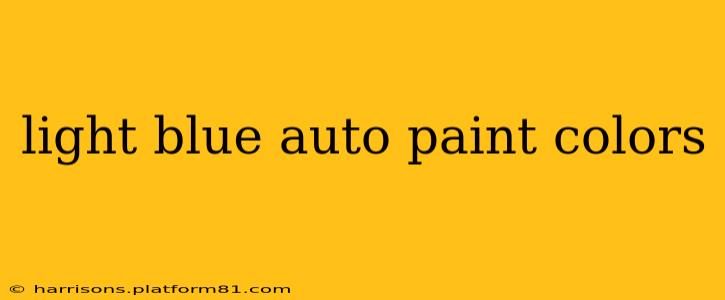Light blue car paint colors offer a refreshing and versatile alternative to more traditional hues. From subtle pastels to vibrant aquas, the spectrum of light blue car paints is surprisingly diverse, catering to a wide range of tastes and vehicle styles. This guide explores the nuances of light blue auto paint, delving into popular shades, naming conventions, and current trends to help you find the perfect light blue for your ride.
What are some popular light blue car paint colors?
The popularity of specific light blue car paint colors fluctuates with trends, but some consistently remain favorites. These include variations on:
- Baby Blue: A soft, pastel shade reminiscent of a clear summer sky. This color evokes a sense of innocence and tranquility.
- Sky Blue: A slightly brighter and more saturated version of baby blue, capturing the vibrancy of a daytime sky. It's often a popular choice for compact cars and sedans.
- Powder Blue: Similar to baby blue but often with a slightly grayer undertone, giving it a more sophisticated and muted appearance.
- Aqua: A more intense and greenish-blue, suggesting the coolness of ocean water. This color tends to be bolder and more eye-catching.
- Periwinkle: This light blue incorporates a touch of purple, creating a unique and calming effect. It often feels softer and more delicate than other light blues.
- Ice Blue: A very light, almost white blue, often appearing almost translucent. This choice lends a sleek and modern feel.
What are some light blue paint color names used by car manufacturers?
Car manufacturers often give their light blue paint colors unique and evocative names, adding a touch of marketing flair. These names can vary significantly between brands and models, but you might encounter names like:
- Azure Blue: Suggests the deep, clear blue of a cloudless sky.
- Celestial Blue: Evokes a sense of the heavens and outer space.
- Ocean Mist: Paints a picture of a calm and serene ocean scene.
- Glacier Blue: Implies a cool, icy tone.
- Arctic Blue: Similarly, suggests a cold, crisp blue.
Keep in mind that the actual color represented by these names might vary slightly depending on the manufacturer and the specific paint formulation. It’s always best to see the color in person before making a decision.
How do I choose the right light blue for my car?
Selecting the perfect shade of light blue for your car depends on several factors:
- Your Personal Preference: Ultimately, the most important factor is your own taste. Consider what feels right to you and complements your style.
- Vehicle Type: The shade of light blue can significantly impact the overall look of your vehicle. A bolder aqua might suit a sporty car, while a pastel baby blue might complement a classic or vintage model.
- Existing Car Features: Consider the color of your car's interior, wheels, and trim pieces when selecting an exterior color. The light blue should harmonize with these features.
- Climate and Lighting Conditions: Lighter shades of blue can appear differently under various lighting conditions. Consider how the color might look in different environments and weather.
What are the current trends in light blue car paint colors?
Trends in car paint colors are constantly evolving. Currently, there's a growing preference for slightly more saturated and deeper shades of light blue, moving away from overly pastel options. Metallic and pearlescent finishes are also increasingly popular, adding depth and complexity to light blue paints.
Are there different finishes for light blue car paint?
Yes, light blue car paint is available in a variety of finishes, including:
- Solid: A straightforward, non-metallic finish.
- Metallic: Contains metallic flakes that give the paint a shimmering effect.
- Pearlescent: Contains pearlescent pigments that create an iridescent, shifting color.
- Matte: A non-shiny, flat finish.
Choosing the right finish will further enhance the look and feel of your light blue car.
How much does light blue auto paint cost?
The cost of light blue auto paint can vary considerably depending on factors like the type of paint (solid, metallic, pearlescent), the brand, the quantity needed, and the application method (DIY vs. professional). Always obtain multiple quotes from reputable paint suppliers or body shops for the most accurate pricing.
By considering these factors and exploring the vast array of available options, you can find the perfect light blue auto paint color to match your personality and vehicle. Remember to always consult with professionals for advice and application, ensuring a long-lasting and beautiful finish.
